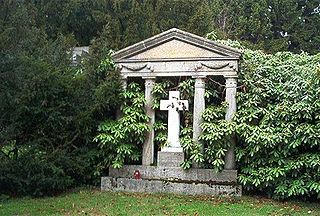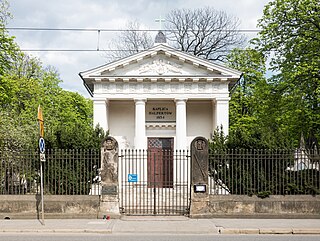
Braunschweig or Brunswick is a city in Lower Saxony, Germany, north of the Harz Mountains at the farthest navigable point of the river Oker, which connects it to the North Sea via the rivers Aller and Weser. In 2016, it had a population of 250,704.

The Vienna Central Cemetery is one of the largest cemeteries in the world by number of interred, and is the most well-known cemetery among Vienna's nearly 50 cemeteries. The cemetery's name is descriptive of its significance as Vienna's biggest cemetery, not of its geographic location, as it is not in the city center of the Austrian capital, but on the southern outskirts, in the outer city district of Simmering.

Wilhelm Raabe was a German novelist. His early works were published under the pseudonym of Jakob Corvinus.

Ohlsdorf Cemetery in the Ohlsdorf quarter of the city of Hamburg, Germany, is the biggest rural cemetery in the world and the fourth-largest cemetery in the world. Most of the people buried at the cemetery are civilians, but there is also a large number of victims of war from various nations. The cemetery notably includes the Old Hamburg Memorial Cemetery with the graves of many notable Hamburg citizens.

The Lutheran Church of the Redeemer is the second Protestant church in Jerusalem. It is a property of the Evangelical Jerusalem Foundation, one of the three foundations of the Evangelical Church in Germany (EKD) in the Holy Land. Built between 1893 and 1898 by the architect Paul Ferdinand Groth following the designs of Friedrich Adler, the Church of the Redeemer currently houses Lutheran congregations that worship in Arabic, German, Danish, and English. The Church, together with the adjoining provost building, is the seat of the Provost of the German Protestant Ministries in the Holy Land. It also serves as the headquarters of the Bishop of the Evangelical Lutheran Church in Jordan and the Holy Land, since this Arabic-speaking (Palestinian) church became independent from the German provost in 1979.

Julius Wilhelm Richard Dedekind was a German mathematician who made important contributions to number theory, abstract algebra, and the axiomatic foundations of arithmetic. His best known contribution is the definition of real numbers through the notion of Dedekind cut. He is also considered a pioneer in the development of modern set theory and of the philosophy of mathematics known as Logicism.

Südfriedhof is, with an area of 82 hectares, the largest cemetery in Leipzig. It is located in the south of Leipzig in the immediate vicinity of the Völkerschlachtdenkmal. The Südfriedhof is one of the largest rural cemeteries in Germany, along with the Ohlsdorf Cemetery in Hamburg and the Stahnsdorf South-Western Cemetery in Berlin.
The Protestant Mount Zion Cemetery on Mount Zion in Jerusalem, is a cemetery owned by the Anglican Church Missionary Trust Association Ltd., London, represented by the Episcopal Church in Jerusalem and The Middle East. In 1848 Samuel Gobat, Bishop of Jerusalem, opened the cemetery and dedicated it as ecumenical graveyard for congregants of Anglican, Lutheran, Reformed (Calvinist) and old Catholic faith. Since its original beneficiary, the Bishopric of Jerusalem was maintained as a joint venture of the Anglican Church of England and the Evangelical Church in Prussia, a united Protestant Landeskirche of Lutheran and Reformed congregations, until 1886, the Jerusalem Lutheran congregation preserved a right to bury congregants there also after the Jerusalem Bishopric had become a solely Anglican diocese.

(Polish: Cmentarz ewangelicko-augsburski w Warszawie), The Evangelical Lutheran Cemetery of the Augsburg Confession in Warsaw is a historic Lutheran Protestant cemetery located in the Wola district, western part of Warsaw, Poland.

Matzleinsdorf Protestant Cemetery is a historic church-owned and operated Protestant cemetery located in the Favoriten district of Vienna, the capital city of Austria.

The Protestant Kaiser Wilhelm Memorial Cemetery is a burial ground in the Westend district of Berlin with a size of 3.7 hectares. The cemetery is under monument and cultural heritage protection.

Viewegsgarten-Bebelhof is a Stadtbezirk (borough) in the southern part of Braunschweig, Germany. The district has a population of 13,121 (2020).

Johann Friedrich Wilhelm Jerusalem was a German Lutheran theologian during the Age of Enlightenment. He was also known as "Abt Jerusalem".

The Hauptfriedhof in Karlsruhe is one of the oldest German communal rural cemeteries. In 1871, the first plans to build a new burial ground outside the city center began. The cemetery was laid out in 1874 by Josef Durm in the Rintheim district, east of the actual city, after the inner-city Alter Friedhof Karlsruhe in the Oststadt had become too small. The main cemetery has grown from its original size of 15.3 hectares in 1873 to over 34 hectares. The graves of more than 32,000 deceased are currently in the cemetery.

(Italian: Il cimitero di San Michele),The San Michele Cemetery has been Venice’s principal cemetery since its creation in 1807. The cemetery is located on an island named Isola di San Michele between Venice and Murano. In addition to the main consecrated Catholic burial ground, there are separate Protestant and Eastern Orthodox sections catering to non-Catholics. Both the cemetery and the island are named after the church of San Michele in Isola built in the 15th century on the island, dedicated to Saint Michael the Archangel . The Jewish cemetery of Venice, however, is located on the Lido island.

The Protestant cemetery of Bordeaux is a historic, church-owned and operated Protestant cemetery located in the city of Bordeaux, in France. The cemetery was inaugurated in 1826 in the district of Caudéran. And the first burial was recorded in March 1827. Enlarged in 1867, a small funerary chapel was built in 1910 on the cemetery ground.

The Evangelical Protestant Central Cemetery in Regensburg is a historic, church-owned and operated Lutheran cemetery located in the city of Regensburg, in Germany. The cemetery is located on a hillside, on the northern slope of Galgenberg, between Friedensstrasse 12 in the north and Bischof-Konrad-Strasse in the south.

The Stahnsdorf South-Western Cemetery is a Protestant rural cemetery in Germany. Established in 1909, the cemetery is located in the municipality of Stahnsdorf in Potsdam-Mittelmark district, Berlin/Brandenburg Metropolitan Region. With a land area of approximately 206 ha, it is the largest church-owned Christian cemetery in Germany, as well as being the tenth largest cemetery in the world and Germany's second largest cemetery after Hamburg's Ohlsdorf Cemetery. The cemetery is operated by the administration of the Berlin City Protestant Synod Association. Due to its status as one of the most important landscape parks in the Berlin metropolitan area, along with the large amount of historically valuable tombs and other buildings which include the landmark wooden chapel, the cemetery was designated as a place of special importance and a protected area by the state of Brandenburg in 1982.

St. John's Cemetery ) is the second cemetery of the same name in Dresden, Saxony, Germany. It is located in the Tolkewitz district of the city. With its 24.6 hectares, the Evangelical Lutheran Johannisfriedhof was the largest cemetery in Dresden until the municipal non-denominational Heidefriedhof was established in 1934.































